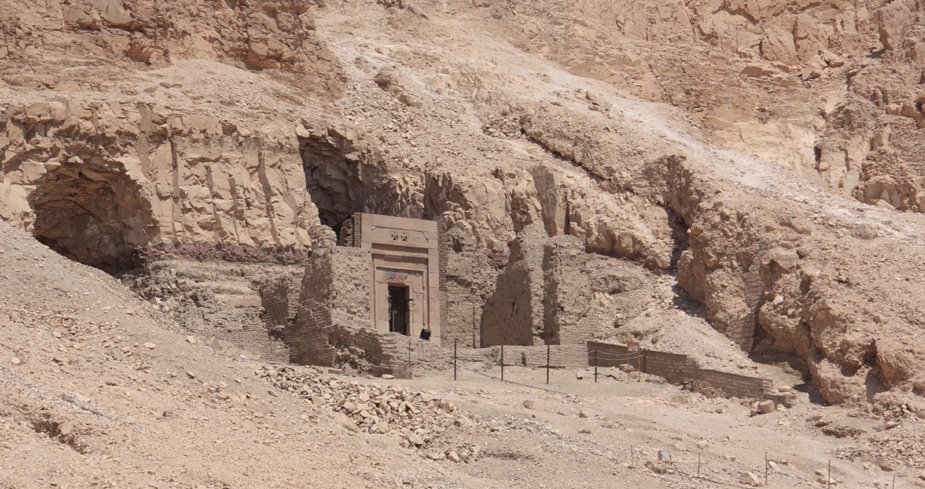Tomb Of Senenmut And Earliest Known Star Map In Ancient Egypt
A. Sutherland - AncientPages.com - The earliest known star map in Egypt was discovered more than eighty years ago and represented the central part of the tomb's decoration; inside the grave, a sketch of the tomb's owner was also found, later identified as Senenmut (Senemut).
Portrait of Senenmut, steward of Amun, in his Deir el-Bahri tomb (TT 252). Photograph by Harry Burton, 1926–27 (M8C 173). Archives of the Egyptian Expedition, Department of Egyptian Art. Credits: The Metropolitan Museum of Art
Senenmut was the steward of Amun, Senenmut, one of the most influential courtiers in the reign of the female pharaoh Hatshepsut and, in fact, her favored courtier.
The tomb (TT 353) is located north of the causeway leading to Hatshepsut's temple at Deir el-Bahri at Thebes on the West bank of the Nile. It was built during the 18th Egyptian dynasty (ca. 1473 BC).
The astronomical ceiling in Senenmut's tomb remains an imposing decoration, divided into two sky panels: southern (depicts decanal stars (small constellations), was often used in ancient Egyptian astronomy. There are also constellations such as Orion and Canis Major.
 TT 353 of Sen-en-Mut (Senenmut tomb) - a hypogeum built by the order of Sen-en-Mut, 97.36m long and 41.93m deep. Image credit: Edal Anton Lefterov - CC BY-SA 3.0
TT 353 of Sen-en-Mut (Senenmut tomb) - a hypogeum built by the order of Sen-en-Mut, 97.36m long and 41.93m deep. Image credit: Edal Anton Lefterov - CC BY-SA 3.0
Over the sky, planets Jupiter, Saturn, Mercury, and Venus are all related to them, sailing in small boats across the sky. The southern part of the ceiling – means the hours of the night.
The northern part (lower part) shows Ursa Major's constellation; the other constellations remain unidentified. On the right and left of it, there are 8 or 4 circles, and below them are several deities, each carrying a sun disk towards the center of the picture.
The inscriptions associated with the circles mark the original monthly celebrations in the lunar calendar, whereas the deities mark the initial days of the lunar month.
Besides the astronomical ceiling in his tomb at Qurna, excavations also revealed 150 ostraca, including drawings, various lists, reports, and calculations.
The astronomical chart on the ceiling from Senenmut's tomb. Creator of the image: : Charles K. Wilkinson - CC0
The history of Senenmut's tomb is relatively obscure. Until the 16th year of Hatshepsut/Thutmosis III's reign, Senenmut still held his offices; then, something happened. His tracks were lost, and his unfinished tomb (TT353) was closed and partially destroyed.
Did he fall out of favor, or perhaps he retired? Maybe he died from natural causes.
His real burial place is unknown. The fascinating ceiling decoration makes us wonder what kind of person Senenmut was. He was born to literate, provincial-class parents, Ramose and Hatnofer. Yet, he rose to prominence during Hatshepsut's regency and became the king's influential and highly respected vizier.
Ostracon found from the dump below Senenmut's tomb chapel (SAE 71) thought to depict his double profile. Now residing in the Metropolitan Museum.
It is believed that Senenmut had more than 80 different titles.
He entered his career as the "Steward of the God's Wife" (Hatshepsut) and "Steward of the King's Daughter" (Neferure), which was confirmed when archaeologists found a statue carved into a deep niche above the façade of Senenmut's offering chapel.
The figure depicted Senenmut with Hatshepsut's daughter Neferure, whom he served as a tutor.
Was Senenmut also an astronomer? What kind of relationship did he have with Queen Hatshepsut? He was in charge of her money, buildings, and campaigns. His access to her was closer than any other person. In more than 20 statues, he is shown hugging Hatshepsut's daughter as a young child.
But just because they were close doesn't mean they had a sexual relationship.
Written by – A. Sutherland AncientPages.com Staff Writer
updated on June 14, 2022
Copyright © AncientPages.com All rights reserved. This material may not be published, broadcast, rewritten or redistributed in whole or part without the express written permission of AncientPages.com
Expand for referencesReferences:
More From Ancient Pages
-
 Baku’s Mysterious Maiden Tower – Legend Of The Daughter Of Fire Who Saved The Sacred Temple May Be True
Featured Stories | Jul 5, 2021
Baku’s Mysterious Maiden Tower – Legend Of The Daughter Of Fire Who Saved The Sacred Temple May Be True
Featured Stories | Jul 5, 2021 -
 Mythical Kingdom Of Prester John – Did It Exist?
Featured Stories | Mar 21, 2016
Mythical Kingdom Of Prester John – Did It Exist?
Featured Stories | Mar 21, 2016 -
 ‘Cradle Of The Scythians’ Studied By Russian-Polish Archaeologists
Archaeology | Dec 20, 2015
‘Cradle Of The Scythians’ Studied By Russian-Polish Archaeologists
Archaeology | Dec 20, 2015 -
 Ullikummi – Genderless, Blind, Deaf Rock Monster Created For Strategic Purposes In Beliefs Of Hurrian People
Featured Stories | Feb 26, 2025
Ullikummi – Genderless, Blind, Deaf Rock Monster Created For Strategic Purposes In Beliefs Of Hurrian People
Featured Stories | Feb 26, 2025 -
 Magnificent Pre-Dynastic City Of Sais And Its Lost Neglected Ruins
Civilizations | Sep 29, 2020
Magnificent Pre-Dynastic City Of Sais And Its Lost Neglected Ruins
Civilizations | Sep 29, 2020 -
 Roman Square Capitals: Prestigious Script That Delighted Human Eye With Its Elegance
Featured Stories | Sep 16, 2019
Roman Square Capitals: Prestigious Script That Delighted Human Eye With Its Elegance
Featured Stories | Sep 16, 2019 -
 Impressive Copper Age 5,000-Year-Old Fortification With Concentric Walls, Bastions, A Shallow Grave With A Man Face Down And A Dagger – Unearthed
Archaeology | Feb 17, 2025
Impressive Copper Age 5,000-Year-Old Fortification With Concentric Walls, Bastions, A Shallow Grave With A Man Face Down And A Dagger – Unearthed
Archaeology | Feb 17, 2025 -
 Beautiful Neolithic Ornate Necklace With Over 2,500 Stones Found In A Child’s Grave
Archaeology | Aug 2, 2023
Beautiful Neolithic Ornate Necklace With Over 2,500 Stones Found In A Child’s Grave
Archaeology | Aug 2, 2023 -
 Enchanted Ancient Egyptian Amulet Seal Discovered In Türkiye’s Amasra
Archaeology | Nov 15, 2022
Enchanted Ancient Egyptian Amulet Seal Discovered In Türkiye’s Amasra
Archaeology | Nov 15, 2022 -
 Two Knights, One Horse − How A Legendary Knights Templar Symbol Has Puzzled And Fascinated Since The Middle Ages
Featured Stories | Jun 3, 2024
Two Knights, One Horse − How A Legendary Knights Templar Symbol Has Puzzled And Fascinated Since The Middle Ages
Featured Stories | Jun 3, 2024 -
 Curse Of Evil Eye: Powerful Ancient Belief That Still Frightens People Around The World
Featured Stories | May 9, 2017
Curse Of Evil Eye: Powerful Ancient Belief That Still Frightens People Around The World
Featured Stories | May 9, 2017 -
 Unearthing Vadnagar And The Search For Hueng Tsang’s 10 Monasteries
Archaeology | Dec 11, 2015
Unearthing Vadnagar And The Search For Hueng Tsang’s 10 Monasteries
Archaeology | Dec 11, 2015 -
 Machu Picchu: Ancient Incan Sanctuary Intentionally Built On Faults
Archaeology | Sep 27, 2019
Machu Picchu: Ancient Incan Sanctuary Intentionally Built On Faults
Archaeology | Sep 27, 2019 -
 Voynich Manuscript: Ancient Book Nobody Is Able To Read
Artifacts | Jun 24, 2013
Voynich Manuscript: Ancient Book Nobody Is Able To Read
Artifacts | Jun 24, 2013 -
 Fossil Of Extinct Human Species Reveals Climate Change Led To Unexpected Anatomical Changes 2 Million Years Ago
Archaeology | Nov 11, 2020
Fossil Of Extinct Human Species Reveals Climate Change Led To Unexpected Anatomical Changes 2 Million Years Ago
Archaeology | Nov 11, 2020 -
 The Olmecs – Who They Were, Where They Came From Still Remains A Mystery
Civilizations | Feb 19, 2015
The Olmecs – Who They Were, Where They Came From Still Remains A Mystery
Civilizations | Feb 19, 2015 -
 Did Lead Poisoning Cause The Fall Of The Roman Empire?
Archaeology | Oct 24, 2017
Did Lead Poisoning Cause The Fall Of The Roman Empire?
Archaeology | Oct 24, 2017 -
 Catherine Of Alexandria Courageously Confronted 50 Pagan Philosophers And Was Sentenced To Death
Featured Stories | Oct 15, 2018
Catherine Of Alexandria Courageously Confronted 50 Pagan Philosophers And Was Sentenced To Death
Featured Stories | Oct 15, 2018 -
 Skaftö Wreck’s Cargo Gives New Answers About 15th Century Trade Routes
Archaeology | Oct 25, 2022
Skaftö Wreck’s Cargo Gives New Answers About 15th Century Trade Routes
Archaeology | Oct 25, 2022 -
 Drinking Milk Increased Ancient Human Body Size – New Study
Archaeology | Jan 18, 2023
Drinking Milk Increased Ancient Human Body Size – New Study
Archaeology | Jan 18, 2023



